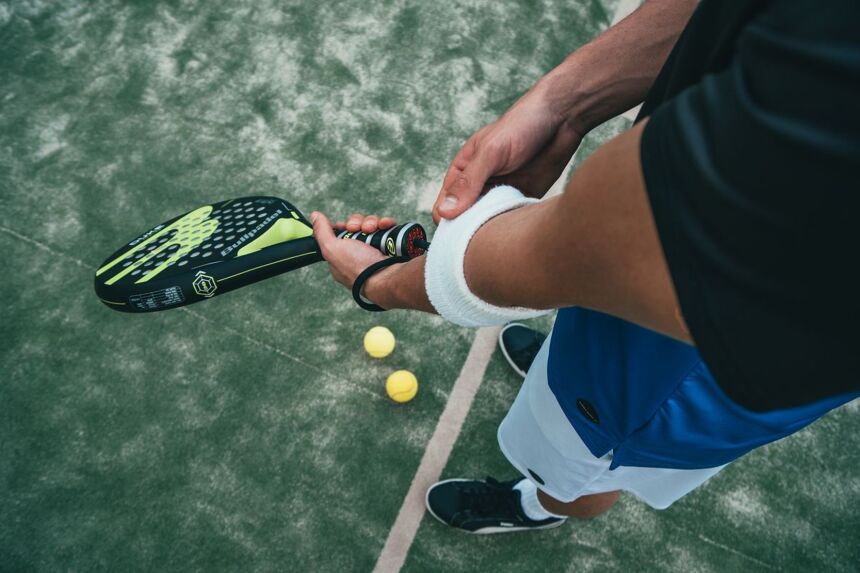The Beautiful Game
Football, or to be precise, Association Football or Soccer, is the most popular sport in the world. If it's not being played, it's being watched, listened to, read about or debated upon.
The origin of the game is not entirely clear; the history goes back centuries with some historic versions of the game still being played today. Folk football, a version of the game popular in medieval times, is still played today in parts of England but it requires some bravery to play this no-holds-barred, unbounded iteration of the game.
As a sport, the power of football can transcend race and culture bringing people together with the one commonality. This was best illustrated during the Great War Christmas 1914 when soldiers from opposite sides laid down their arms to meet in No-Mans-Land for carols and a game of footie.
Health benefits of playing football
In the UK 1.9 million admit to playing football at least twice a month each year (ref). Not that we need a further excuse to have a kick-about, but regularly playing football comes with health benefits:
- Blood pressure control - regular recreational football can help lower high blood pressure
- Reduce cholesterol - playing football regularly can lower your total and "bad" cholesterol (LDL) level
- It can increase your VO2 max, a measure of how aerobically fit you are, by as much as 7-15%
- and can increase bone density by up to 5.4% in previously sedentary individuals.
Football injuries
Injuries from playing football are a common occurrence with roughly 2/3 a result of contact with another player. More injuries occur during matches than in training.
Common soccer injuries include:
- Ankle sprain
- Knee injuries - Medial collateral ligament (MCL), Meniscus, Patellar tendon, ACL
- Groin injuries
- Hamstring muscle strain
- Calf muscle strain
- Muscle contusion
- Skin abrasions
- Fractured/broken bones
- Concussion
The impact of an injury can be just as devastating for the professional athlete as it is for the weekend warrior. The psychological impact of not being able to do what you are known for or the unplanned disruption of your social outlet should not be underestimated. This is why following an injury, it is important to get an early diagnosis and a plan to recovery to give you a goal to work towards.
If you have a football injury that you are concerned about, click here to make an appointment with Dr Ade.
Outside of breaking into a canter to avoid missing the last train, or tearing after your runaway toddler, in one year roughly 70 million people in England consciously chose to put on a pair of trainers for the sole purpose of running at least twice in 28 days, making it the most popular sport in the country.
Running is not limited to pounding the pavement jogging but also includes activities like track sprinting, fell-running and parkour/free running. The variety means that no matter what your age or fitness level is you can always find something that is suited to you whatever your motivation is - thrill-seeking, lover of the great outdoors etc.
Health benefits of running
What's great about running is that not only is it accessible - you only need a pair of trainers to get started and you can do it just about anywhere, anytime - it also has a number of confirmed health benefits:
Cardiovascular health - It's one of the best "cardio" exercises to control body weight and improve your cardiovascular profile (lower resting heart rate, controlled blood pressure, higher levels of HDL/"good" cholesterol) and you don't have to do that much of it to benefit from its positive effects: simply jogging 5-10 minutes a day, or 50 minutes each week, can reduce your risk of death from cardiovascular disease by as much as 50% (ref).
Better sleep - Chemicals released during and after a run relaxes your body and encourage a deeper more restful sleep. Although, you should try to avoid high intensity running/sprinting at least one hour before bedtime to avoid being overstimulated and kept awake.
Improves knee and back health - Contrary to myth regular runners have a lower incidence of knee and back arthritis compared to sedentary equivalents, and in the majority of cases, symptoms of arthritis are improved with self-selected running programmes (ref).
Improves mood and reduces anxiety - When you run for 30 minutes or more your body releases endocannabinoids, similar to cannabinoids in cannabis. This naturally produced chemical can cross into the brain to give you the feeling of calmness and reduced stress. The "Runner's high".
Endocannabinoids also increase your dopamine levels(the reward chemical) adding to the feel-good factor after a run. You can see why some people say they NEED to run to de-stress.
Improves memory and may reduce the rate of cognitive decline - Running increases the blood flow to the part of the brain important for memory (the hippocampus) and in so doing improves your working memory and focus. Regular running also stimulates new nerves forming and new connection pathways in the adult brain, the hippocampus again, which may reduce the rate of cognitive decline.
Running. Too much of a good thing?
The downside of regular physical activity is the risk of injury. Roughly 60% of runners will have an injury at one time bad enough to stop them from running for several weeks. The repetitive nature of the activity means that the majority of injuries are due to overuse with the most affected areas being the knees, shin area, feet, ankle and lower back.
Common running injuries for recreation runners include:
- "Runner's knee"
- IT Band injury
- High Hamstring Tendinopathy
- Patellar tendinopathy
- Shin splints/medial tibial stress syndrome
- Achilles Tendonitis
- Stress fractures
- Plantar fasciitis
- Foot pain
Many running problems are avoidable and when they occur are treatable. The key is to address any tweaks and twinges early before they worsen.
If you feel pain at a level of 5 or more, where 10 is worst if the pain interferes with your daily life or continues for two or more weeks seek medical advice.
For individuals with existing medical problems, one concern is knowing if they can or should start running. Knowing where to get advice for this is a common issue they face.
As a Consultant in Sports and Exercise Medicine Dr Ade has experience working with individuals of all ages, at different stages of their health and fitness journey, and is ready to help you get started on your fitness journey.
Rugby is a globally popular sport played by both males and females. The two codes, union and league, are played by over 8.5 million people around the world. Shorter, less complex, formats of the game exist with the sevens (7-a-side, played in seven-minute halves) format now a recognised Olympic sport. And in case you wish to try out the sport but are put off by the physical nature there is always a tag/touch version of the game.
To play rugby you need the running endurance of a soccer player (the average distance covered by a professional rugby player in a game is 7 km vs 11km for a soccer player) and the physicality of an American football player.
What are the benefits of playing rugby?
The most obvious benefit of playing rugby is that it's an excellent way to get fit!
It helps you develop your strength, speed, agility, balance, coordination, power, endurance, concentration, decision-making skills and teamwork. It can be used as part of a fitness regimen or simply enjoyed recreationally.
Needless to say, the rugby community is very sociable and inclusive.
Is rugby a safe sport?
![Likelihood of match injury compared across playing levels]() Likelihood of match injury compared across playing levels
Likelihood of match injury compared across playing levels
All contact sports have an inherent risk associated with them.
In rugby, your risk of injury depends on what level you are playing the game at. The older and higher your level of participation, the greater your chances of picking up an injury.
- Chart from CRISP Project. EnglandRugby.com
Can rugby injuries be prevented?

The nature of rugby means that injuries cannot be eradicated, but there are things you can do to reduce your risk of getting injured:
- Warm-up properly before games.
- Ensure you get adequate rest and recovery between games. This also includes appropriate nutrition and good hydration.
- Wear the correct footwear for the playing surface, and your playing position (front row vs backs).
- Wear protective gear such as mouth guards, headgear (to protect your ears only. Does not prevent concussion), shoulder foam pads or long sleeve leggings for unforgiving playing surfaces.
- Complete the RFU Activate injury prevention - 26-40% fewer soft tissue injuries, 29-60% fewer concussions.
What are the most common injuries in rugby?
With running and jumping, a major feature of the game there is the potential for overuse injuries like Achilles or patella tendinitis. However, the collision nature of the sport means that traumatic injuries, sustained during a tackle and/or impact with the ground, are more common.
Top 5 common injuries in professional rugby union 2019/20:
For the latest information on the injury profile of rugby union across all levels in England follow this link to the England Rugby Injury Surveillance and Prevention Project site.
Why see Dr Ade with your rugby injury?
I've always been enthusiastic about rugby, playing on the wing for school and university, eventually hanging up my boots when career and family took precedent. My fondest memory as a player was playing for the Epsom College mighty 3rd XV team when we went a whole season unbeaten!
As a sports medicine physician, I have been able to marry up my enthusiasm for sports and my need to care for patients. I was fortunate to have provided care for England U16 and Saracens Rugby club over several seasons and now sit on a player welfare advisory group for the English Rugby Player's Association (RPA).
When people think about racket sports tennis, badminton and squash usually come to mind but there are many more than these three played around the world from recreational to international level. Table tennis for one and Padel tennis, the world's fastest-growing racket sport. What they all have in common is the use of a racket to hit a projectile (a ball or a shuttle) with the arm at varying heights.
What causes racket sports injuries?

Most injuries that occur are the result of repetitive action causing overuse injuries, with the racket holding arm mostly affected.
Acute injuries can occur through the process of getting around a court (rolled ankle) or attempting an explosive action (a muscle strain or prolapsed disc). The frequency of injuries depends on the sport and the level you are playing at:
- elite tennis players get more injuries to the spine in comparison to the recreational player
- a badminton player is more likely to develop wrist pain.
Common racket sports injuries
Shoulder
- Rotator cuff conditions
- Biceps tendinitis
- SLAP lesions
- Osteoarthritis
Elbow
- Tennis elbow
- Golfer's elbow
- Posterior/back of elbow impingement
- Ulnar Collateral Ligament (UCL) sprain
Wrist/hand
- de Quervain's tenosynovitis
- Triangular fibrocartilage (TFCC) tear
- Wrist ganglions
- Wrist tendonitis
Lower extremity
- Patella tendinitis
- Medial tibial stress syndrome (MTSS)
- "Tennis leg" - Partial or complete rupture of the calf muscle
- Achilles tendon rupture
- Ankle sprain
- Tendonitis around the ankle
- Plantar fasciitis
Trunk
- Low back pain - various causes including facet pain, herniated disc, stress fracture
- Rib stress fracture
- Abdominal muscle strains
What is Functional Fitness?
To be "functionally fit" means having the ability to perform at your desired level of activity - whether that's being able to sit and stand from a chair unaided (squatting), pick-up and walk with your shopping (dead-lift and farmer's walk), place luggage in an overhead space (shoulder press) or play sports.
Functional fitness describes any exercise programme aimed at improving your body's natural ability to move in order to keep you healthy, strong and fit for life. This typically includes a combination of strength training, cardiovascular, flexibility exercises and balance work.
How is functional fitness different from other types of exercise?
Purists may say that functional fitness focuses on movement patterns rather than isolated movements like those seen in traditional workouts. So, Instead of doing sit-ups, pushups or leg-press on a weights machine, you may find yourself doing burpees, box step-ups, skipping or battle rope exercises.
The reality is any physical activity that improves your overall fitness through increasing muscle mass and endurance, while also improving balance and coordination, can be regarded as functional fitness. Yes, even the aforementioned leg press can be considered functional if the goal is to restore strength in a weakened muscle group.
Examples of functional fitness programmes
If you have done a Jo Wicks workout, a Zumba or Barre class you already have some experience of functional fitness training. Exercise programmes uniquely branded as functional fitness though, include:
As much a training ethos (train for everything, expect the unexpected) as it is a community. Crossfit training involves constantly varied high intensity/high volume exercises that incorporate elements of Olympic-style weightlifting, gymnastics, endurance and sprint exercises across all mediums (on water, in water, on land). It is equally participated by males and females and the programme is suitably scaled for all ages and abilities.
Competitive CrossFit has become a global phenomenon with several national and international events taking place each year with ever-growing prize purses. The annual CrossFit Games is an open event to find "the fittest on earth" by gender, age, individual or team. Find your nearest CrossFit affiliate here.
F45 is an international chain of fitness studios that run 45-minute circuit-style classes of high-intensity functional training. Every studio around the world does the same exercise programme that changes daily. So, it's great if you happen to travel a lot and want the familiarity of a workout environment without the fear of repeating a routine.
Every class begins with a trainer demonstrating the movements to come. These include exercise modifiers to cater for all levels of fitness. Find your nearest F45 studio here.
Barry's is one of the first mass commercial high-intensity interval training (HIIT) fitness workouts that aim to improve your cardiovascular fitness and strength by alternating cardio workouts (treadmill or spinning) with floor-based strength workouts. Maintaining an elevated heart rate for the almost 50-minute workout means that you get a good calorie burn in the process.
Classes take place in lowly-lit, red-hued, well-ventilated studios to a background of pumping motivational music. Find your nearest Barry's here.
Be Military Fit (BMF), previously known as British Military Fitness, are group fitness classes mostly held in outdoor public areas around the UK. The workouts are led by current or ex-members of the British Military who are in no way intimidating.
Utilising motivational techniques honed in the forces instructors put you through workouts, some of which requires teamwork. The sense of camaraderie, coupled with the unique feeling that comes from exercising in the elements, can be a strong motivator. Find your nearest BMF venue here.
Total body HIIT workouts that focus on improving your endurance, power and strength. The one-hour classes have you rotating between three stations of rowing, treadmill and weights all the while monitoring your heart rate with technology. The aim is to maintain your heart rate at 84-91% of your maximum, the orange zone, for as long as possible to create an "Excess Post-Exercise Oxygen Consumption" (EPOC), or afterburn. In short, workout so hard that you continue to burn calories after you finish.
Find your nearest Orange Theory Fitness venue here.
With any physical activity, there is always a risk of injury. This can either be an acute injury, like a muscle strain in a weight lifter or runner, or an overuse injury from doing too much of the same thing. The nature of functional fitness workouts is that they are meant to be varied which means the chances of repeating the same movement often, and risk an overuse injury, is small.
When an injury does occur, in some instances it may have to do with your physical makeup and simply treating the injury may not be enough to stop it from happening again. You may require a physical assessment to identify an underlying cause that can then be addressed.
I am a big advocate of functional fitness training which so happens to be my personal choice of keeping fit. If you are concerned about an injury or wish to discuss any concerns you may have around your exercise regime click here to make an appointment.
What are combat sports?
Combat sports involve forced physical contact between two participants. They are usually executed through a variety of moves such as striking, grappling, kicking, weapon handling or a combination of moves.
Common examples include boxing, pro-wrestling, kickboxing, judo, karate, taekwondo, jujitsu, capoeira, Brazilian jiu-jitsu, Greco-Roman wrestling, mixed martial arts (which can include all of the aforementioned) and many more.
To the un-indoctrinated, the perception of a combat sport is something either done for competition (boxing, MMA) or associated with entertainment (movies, WWE). In reality, many disciplines are practised around the world for a number of reasons:
- Self-discipline
- Confidence
- Fitness
- Occupational requirement
- Entertainment
- Leisure
It doesn't matter whether you are an Anthony Joshua, Roger Gracie or Ronda Rowsey what all the combat sports have in common is that they are total body activities that require a combined skill-set of speed, power, endurance and agility.
Managing combat sports injuries
The total body nature of most combat sports means that injuries can occur from overuse or trauma and can affect any part of the body. You can literally get injured anywhere from head to toe depending on what you are doing and with whom.
Seeing a clinician that has an understanding of the nature of your sport and the ways an injury can occur means they will be able to plan your recovery with an appreciation of what you are looking to return to doing.
If you have sustained an injury that you are concerned about contact us here to find out how we can help.
If someone told you 10 years ago that you could make a healthy living playing video games you'd probably laugh.
Today, this is one of the fastest growing entertainment sectors in the world.
The professionalisation of an activity usually leads to higher stakes being played for. This leads to greater training intensity which in turn can result in complications, physical and mental. ESports medicine focuses on the health and well-being of this new breed of "athletes".
What is eSports?
ESports, or electronic sports, is competitive video gaming. The term was first coined in the early 1990s by a group of computer programmers who wanted to distinguish their hobby from other forms of gaming such as board game competitions. In recent years, it has become one of the most popular spectator sports worldwide with millions of fans watching online or at live events.
How big is eSports?
Whatever your thoughts are about video gaming as a sport or past-time we cannot ignore it as an entity:
- 2020, in the UK alone, video gaming generated sales of roughly $3.5 billion. To put this into perspective, Premiership Football had revenue of $4.5 billion in the same period.
- Tournament prize pools are now as much as $34 million with the winners taking home over $15 million!
- Several traditional sports teams, around the world, have invested in an eSports division, increasingly making it a viable way to earn a living.
But is eSport a real sport?
ESport athletes require high levels of concentration, reaction times and fine motor skills. They can train as much as 7-9 hours a day with an intensity comparable to athletes in traditional sports.
Many educational organisations around the world recognise the growing professionalism and now offer scholarships in eSports alongside traditional athletic ones.
In 2017 the International Olympic Committee (IOC) concluded that competitive video gaming can be considered a sporting activity. ESports will formally debut in the 2022 Asian Games, what I believe is a precursor to its entry to the Olympic Games, with medals to be awarded in 8 events.
What is eSports medicine?
ESports medicine is the subfield of sports medicine that focuses on the health and fitness of intense video gamers. In addition to performance, it considers the impact (positive and negative) video gaming may have on your physical and mental well-being.
Examples of eSport related conditions include:
- Gaming injuries - carpal tunnel syndrome, gamer's thumb, gamer's elbow
- Mental health - addiction, anxiety
- Obesity and risk of cardiovascular disease.
As a Consultant in Sports and Exercise Medicine our skill-set and professional network, developed through working in different sports disciplines uniquely positions us to manage any physical and medical issues that can arise as a result of excessive video gaming.
Swimming is one of the most popular forms of physical activity around the world. In England alone, prior to the Covid-19 pandemic, approximately 4.2 million of us swam at least two times a month making it the 8th most participated sport in the country; swimming is the most popular sport among children aged 5-10 years (ref).
With many of us using swimming as a primary form of exercise or as an alternative, due to injury or part of an injury rehabilitation programme, it is inevitable that injuries will occur.
The benefits of regularly swimming include
- It's a form of exercise you can continue throughout your lifetime.
- It's a life skill that can save your or someone else's life.
- It gives you a total body workout, as nearly all of your muscles are used, toning muscle and building strength in the process.
- It keeps your heart rate up whilst taking some of the impact stress off your body.
- It builds your endurance and cardiovascular fitness.
- Improves your core strength and flexibility which can help with controlling/preventing low back pain.
- It can improve your mental health by reducing stress and anxiety and increasing self-confidence.
Common causes of swimming injuries
Swimming is unique in that it combines upper and lower body strength exercising with cardiovascular training all in a non-weight bearing environment. The highly repetitive nature of the activity +/- improper technique means that overuse musculoskeletal injuries account for the majority of swimming-related injuries. The most commonly injured sites are the upper limb, knees and spine.
Acute muscle strains can still happen from performing explosive actions like diving off blocks or kicking hard through the water. Also, we must not forget that in watersports that involve multiple participants (e.g. water polo) it is still possible to develop contact injuries similar to what is seen in land-based collision sports (e.g. concussion, contusions and facial injuries).
Common swimming injuries
Swimmer's shoulder
A broad term used to cover all potential causes of shoulder pain in swimmers. Pain which is usually located around the front of the shoulder can be caused by:
- Abnormal shoulder mechanics leading to rotator cuff impingement
- Overuse fatigue of the muscles around the shoulder
- Shoulder laxity resulting in instability
- degenerative changes like a labrum tear, shoulder joint osteoarthritis or rotator cuff tear.
Treatment requires identifying the root cause of the problem in order to address it so the symptoms do not keep recurring.
Breaststroke swimmer's knee
The knee is the second most reported site of pain in regular swimmers with breaststroke swimmers at a 5x greater risk of developing knee pain.
Low back pain
All swimming strokes require you to maintain hyperextension of the lower back to achieve a streamlined position; this position is exaggerated in the "undulating" nature of breaststroke and butterfly. The high intensity and repetitiveness of these two strokes load your lumbar spine, leading to an increased increase risk of damage. Using training devices such as fins, kickboards, or pull buoys may worsen increase your risk of low back pain by increasing the hyperextension of the lumbar spine.
Medical conditions associated with swimming
In addition to musculoskeletal injuries, swimming poses a number of medical challenges due to the variety of environments it can take place. Naturally occurring irritants and pathogens or chemical exposure commonly cause respiratory and skin conditions in swimmers. Conditions like:
- Chemically or exercise-induced asthma
- Rhinosinusitis
- Chest infections
- Ear infections
- Skin infections and allergy
It is important you see a doctor if you are getting symptoms associated with swimming to ensure you get an early diagnosis and treatment so as not to affect your performance and your ability to enjoy your sport.
If you have sustained an injury through cycling, you are having difficulty with a cycling-related injury or are concerned about cycling with a medical condition, let me help you get back on your bike. Click here to make an appointment.







